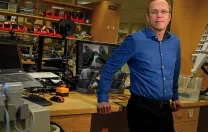Sensors, actuators, and controllers are the robotic analogue of a nervous system. Sensors guide a robot, and actuators make things happen. The lab of Armstrong professor of engineering and applied sciences Frank Doyle, Paulson dean of the School of Engineering and Applied Sciences, focuses on the “brains”—specifically the control dynamics of an artificial pancreas. This robot is designed to perform for individuals with diabetes what sounds like a deceptively simple task: reading a single input—blood glucose levels—and then administering an appropriate dose of insulin to stabilize those levels.
But because every person responds differently to foods, physical activity, and stress, no system can yet reproduce the exquisite and immediate control delivered by a real pancreas. One problem, explains Doyle, is the lag that occurs when reading a person’s blood glucose level, or administering a dose of insulin. The body’s own glucose-sensing and insulin-producing beta cells have direct access to the portal vein, and can detect and respond immediately to shifting glucose levels. The artificial pancreas, on the other hand, works through subcutaneous interfaces, which introduces lags into the system.
To cope with the lags and individual variability, Doyle’s group pioneered the concept of predictive zone control: using medical data to define upper and lower limits for glucose levels, rather than a fixed, optimal target. “This is different from a thermostat, where you might set it to 70 degrees,” he explains. “The key with diabetes is there’s not a magic number.” The system is instead designed to stay within a range that avoids medical complications.
In subsequent work, Doyle’s research has sought to monitor and address the needs of particular subpopulations, refining and adapting his control algorithm. Young children, pregnant women, shift workers, the elderly, and athletes, for example, each require different strategies for controlling glucose. And for each of these groups, other circulating hormones, such as cortisol, lactate, and ketones, will play different roles in modulating the effects of insulin. Such customization in medical robotics—putting better controls, literally, into users’ hands—is evolving rapidly; the latest iterations of Doyle’s algorithms, licensed for use in Europe and the United States, run on a smartphone.









